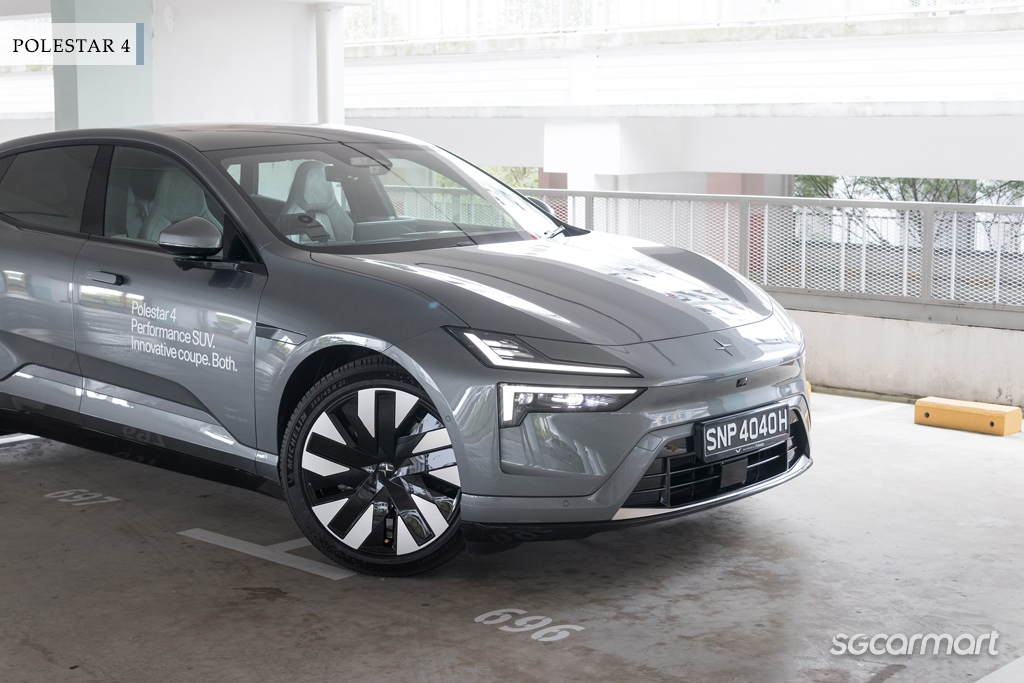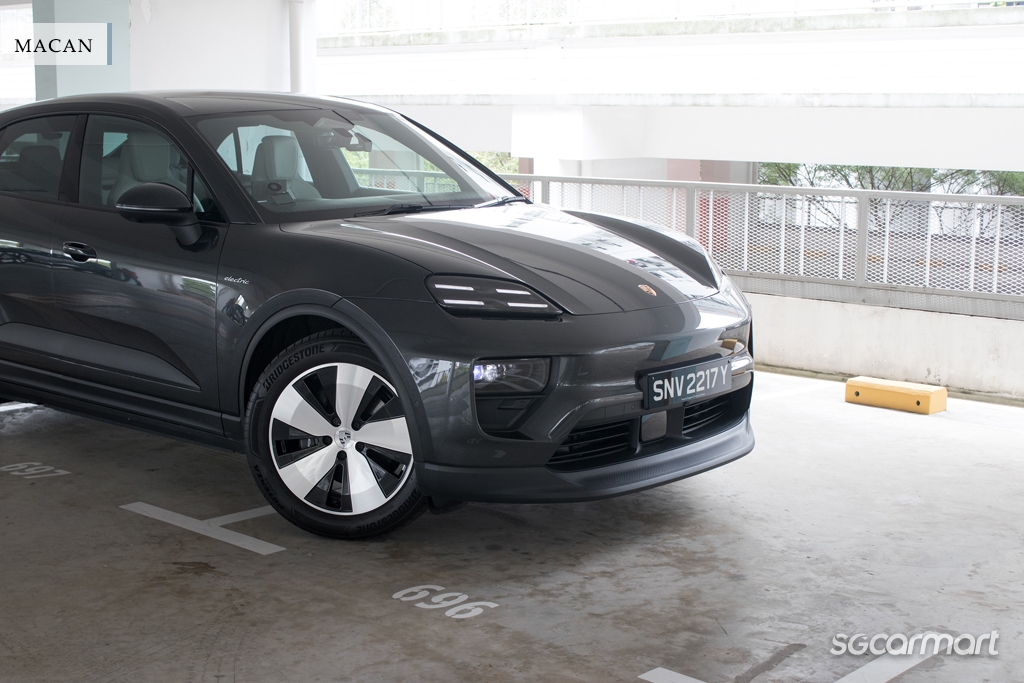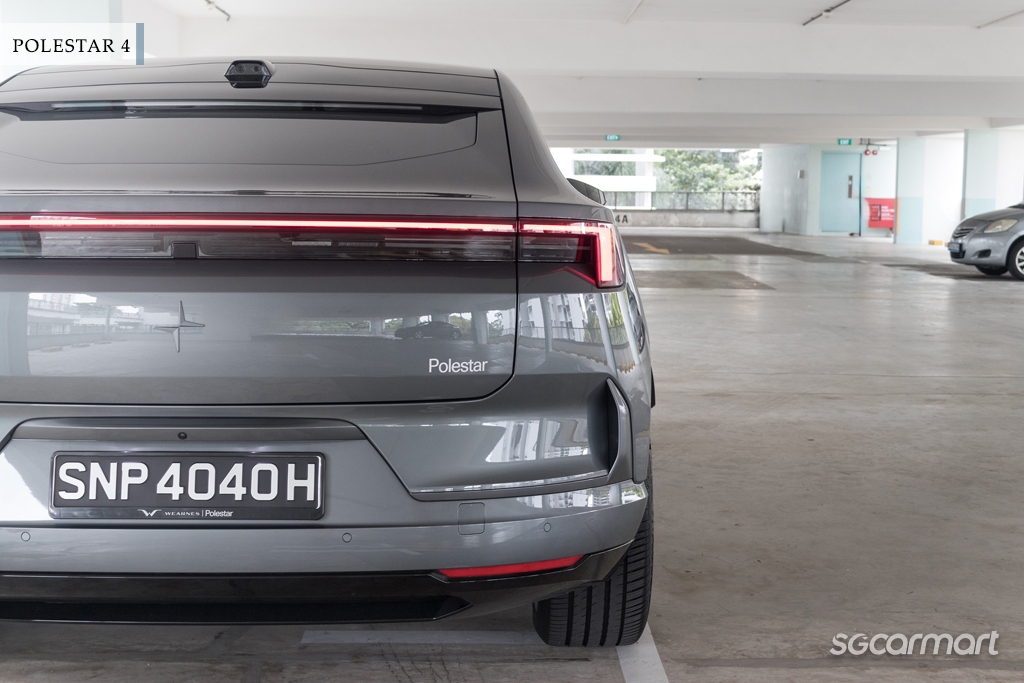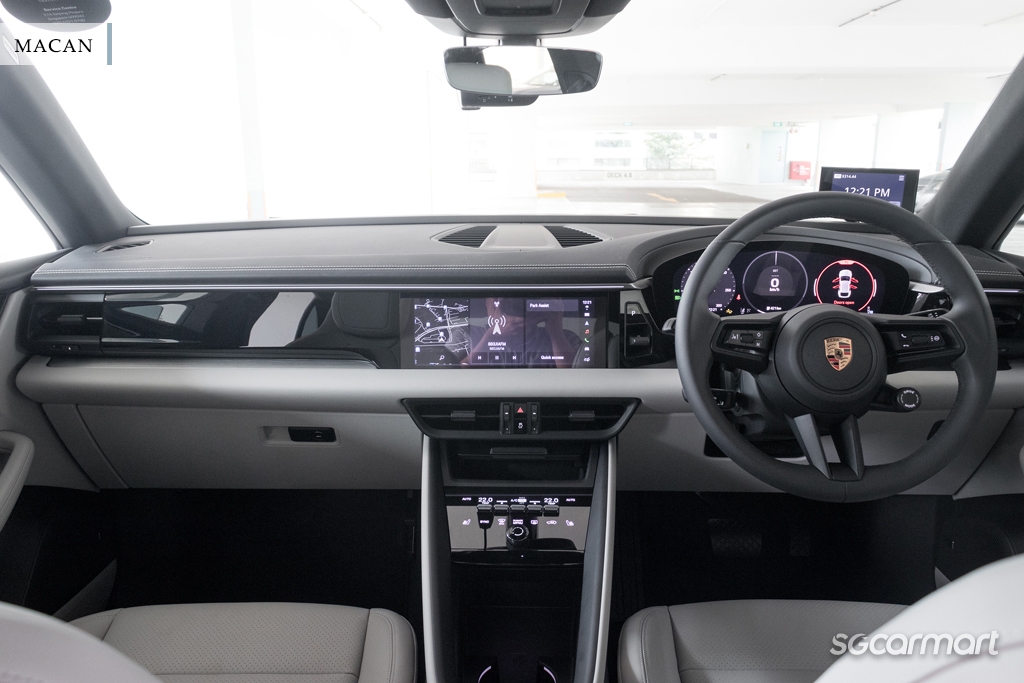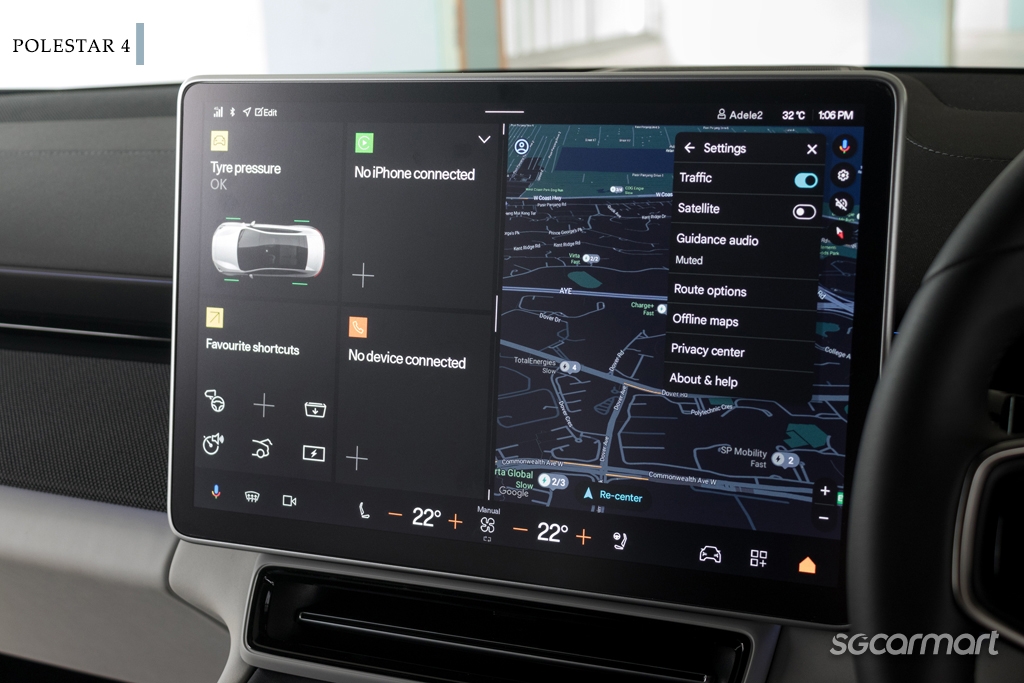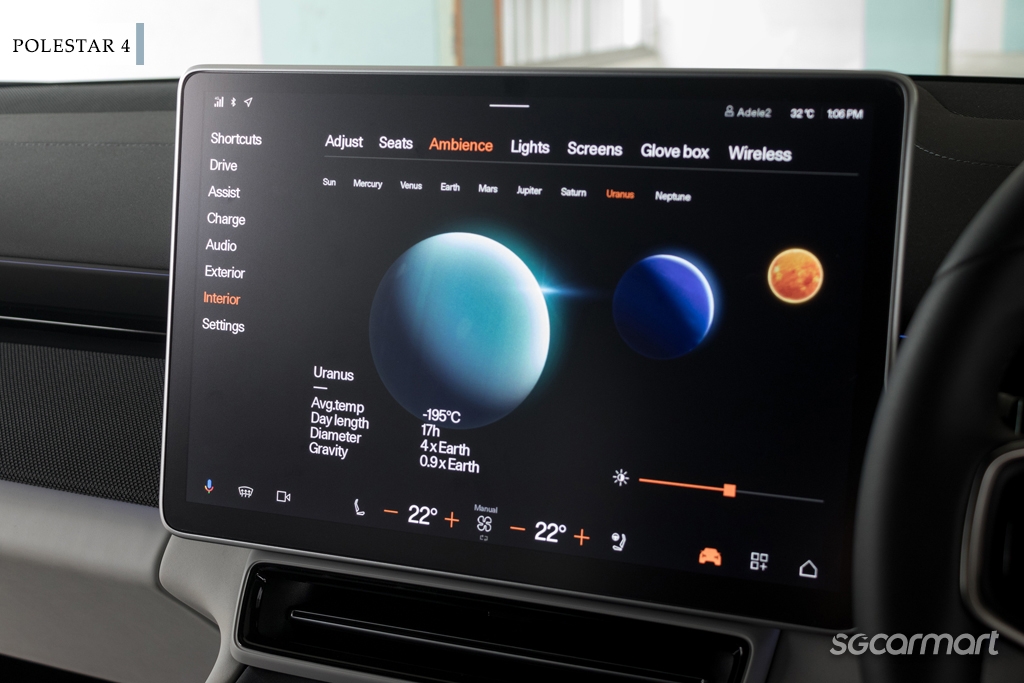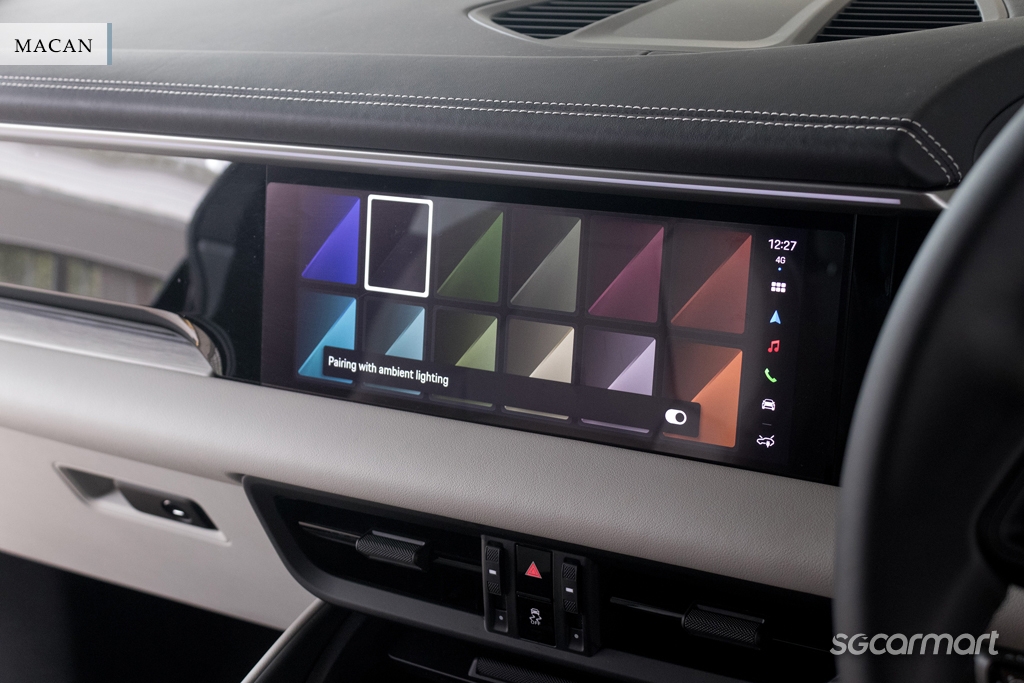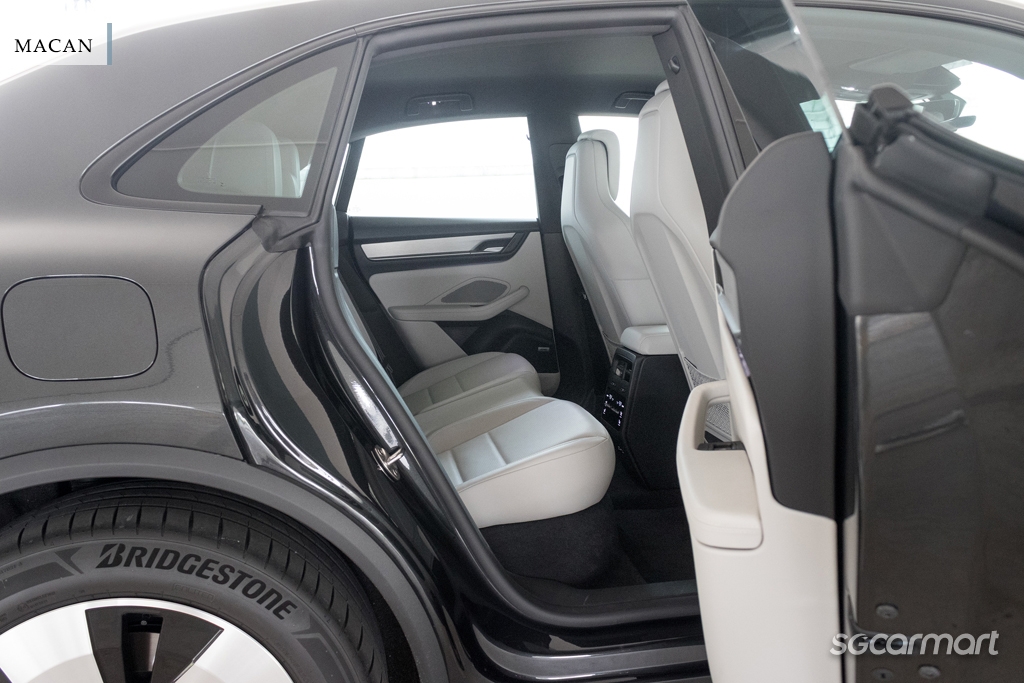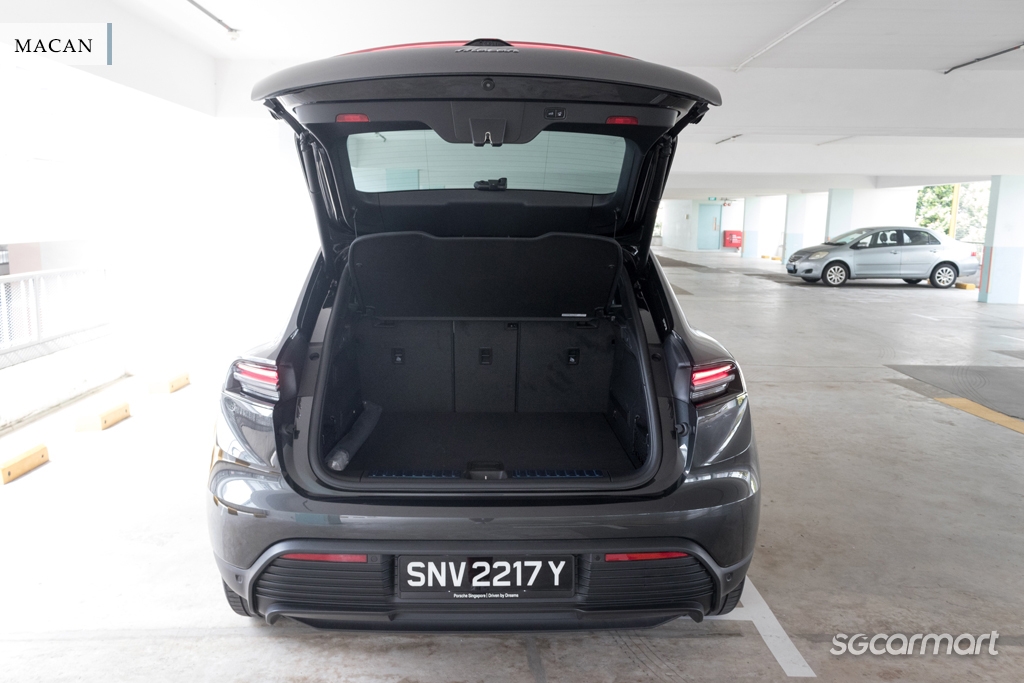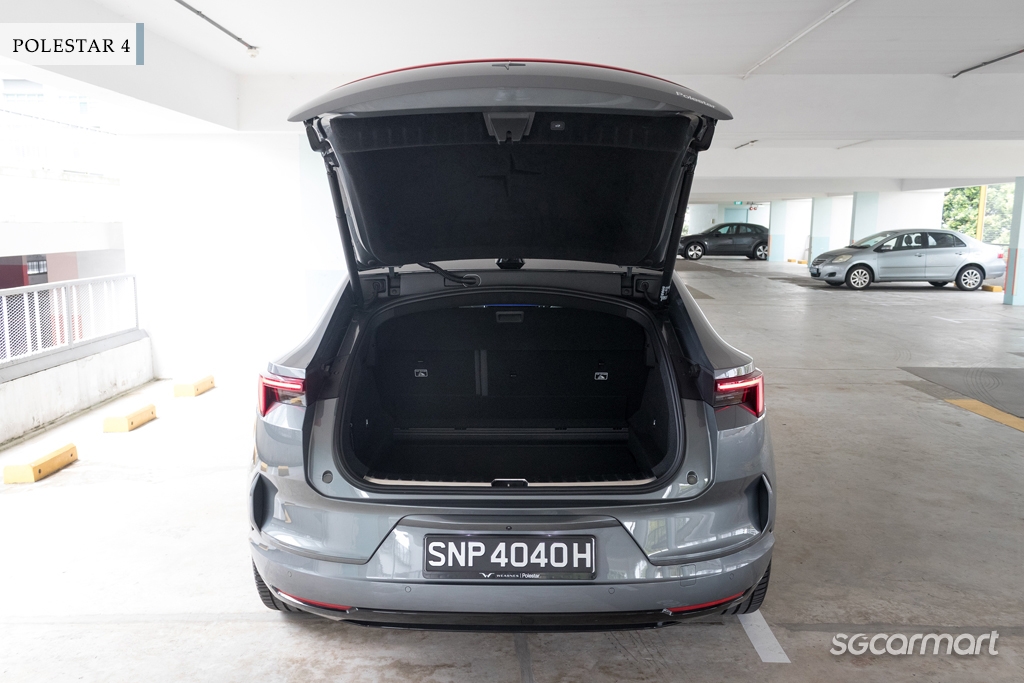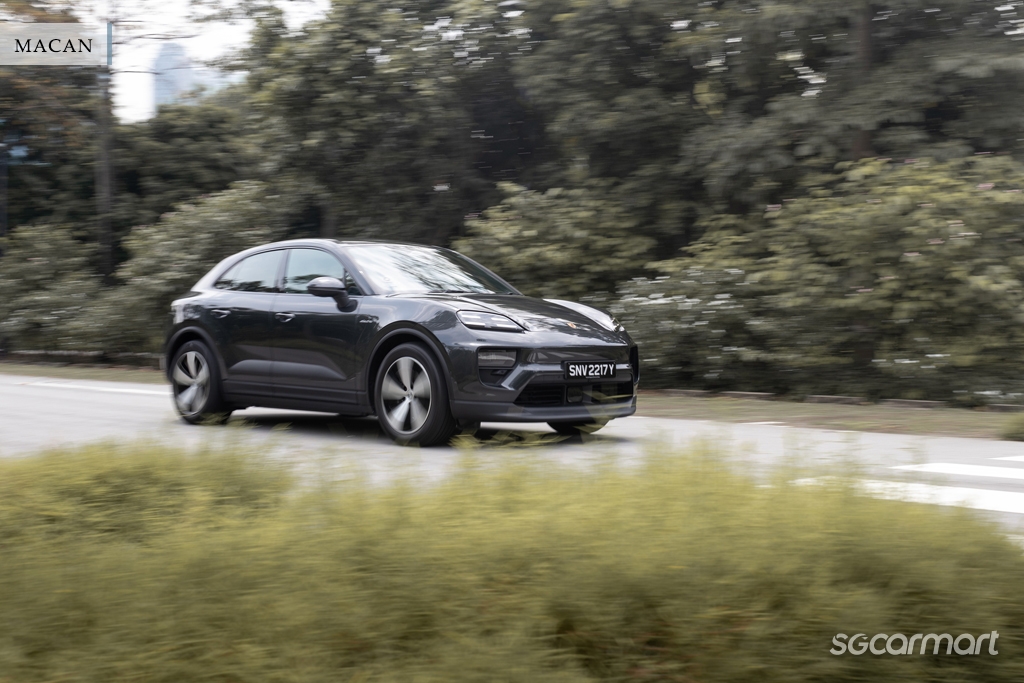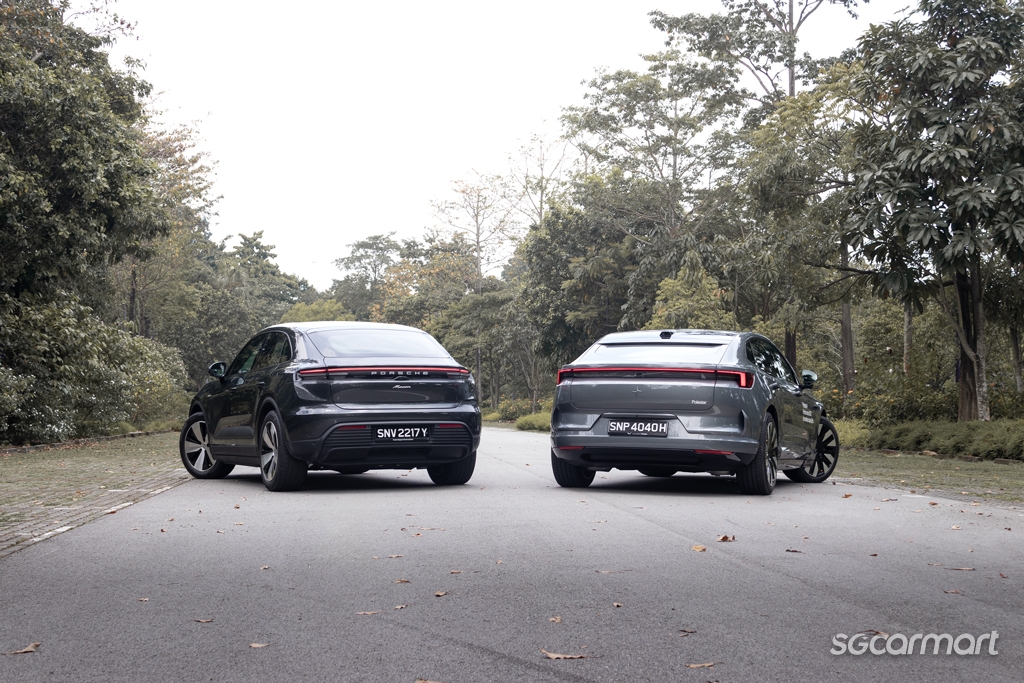Polestar 4 LRSM vs Porsche Macan Electric
18 Apr 2025|5,939 views
Polestar 4 Long Range Single Motor
Larger footprint, roomier cabin
Bigger boot capacity
Fewer physical buttons
Less power and torque
Keener handling
Porsche Macan Electric
Sharper, more precise steering
Hotter performance
More versatile boot
Driver-centric cabin and displays
Wider scope for personalisation
When carmakers challenge one another, the competition results in better options for drivers. Segment leaders must not only sit up and take notice, but also further hone their models to fend off new rivals.
Porsche has long dominated the premium mid-size SUV segment with the Macan, a model feted for blending the versatility needed by families, off-roading abilities, and on-road performance. It's a combination that's been widely successful.
Aiming to knock the Macan off its perch is the Polestar 4 Long Range Single Motor. The Swedish brand's take on the 'SUV coupe' has no issue turning heads, but does it also have the flexibility and the drive to unseat its Stuttgart rival?
Design dimensions
Having been around over a decade, the Porsche Macan is more recognisable than its rival. Despite its more hunkered down stance, the Macan's familiar rounded silhouette is obvious even from afar.
Now in its second generation, it's even more distinct thanks to those 'four dash' daytime running lights (inspired by the Taycan) and single-bar rear taillight. The Porsche DNA is strong - nobody would mistake this as a model from any other brand.
The Macan is recognisable, but the 'missing' rear windscreen makes the Polestar 4's rear especially distinctive
The Polestar 4, though, is a head-turner. The brand's version of an 'SUV coupe' is a handsome one, with split-head lights, a chiselled bonnet, and sharp lines that speak to its athletic character. From a distance, one might even assume it's a large sedan.
'Large' is an apt description for the Polestar 4, for it is longer (4,840mm vs 4,784mm), wider (2,008mm vs 1,938mm), and has a lengthier wheelbase (2,999mm vs 2,893mm) than the Macan. But it also looks sportier than the Macan thanks to its lower roofline (1,534mm vs 1,623mm). When it comes to looks, the nod goes to the Polestar 4.
The Macan's cockpit immediately feels driver-centric, while the Polestar 4's exudes a modern, luxurious vibe
Driver's environment
Porsches are driver-centric and the brand's driver-focussed nature is clearly felt in the Macan. There is a rightness to the cockpit and seating position, and there are more physical buttons here than in the Polestar 4 for greater convenience.
Climate controls, one of the most-accessed functions, are toggles on the centre console, offering a tactility that's missing in the Polestar 4. Actual buttons can be found on the steering wheel, along with a useful Drive Mode dial for quickly swapping between settings.
And when you do have to access the infotainment system, it's just as simple as the Polestar's, although some might prefer the latter's more generous screen size, which is arguably what buyers expect these days.
The Macan's infotainment display is smaller and has fewer menus, while the Polestar 4's impresses with its bolder colours
One of the Macan's bugbears, though, is that the On/Off button is on the right of the steering wheel, whereas the gear selector is on the left. That means needing two hands to get moving - they should have been placed beside each other instead.
While the Macan is about functionality and sensibility, the Polestar 4's cockpit is decidedly modern. It has even fewer buttons than the Macan, but like its rival, most functions are also in the infotainment system.
Compared to the Macan, the Polestar 4's infotainment has more menus, but fortunately, these are easily figured out even for first-time users. You won't get lost as you adjust the driver safety features, tweak the One-Pedal Drive (regenerative braking) power or set the charging limit.
The Polestar 4's ambience options are presented in an 'artsier' manner compared to the Macan, which does it in a more straightforward fashion
Polestar’s approach has drawbacks, though. The instrument panel layout, for one, is more computer-like than car-like, unlike the Macan's, which is inspired by Porsche's five-dial layout. The haptic buttons on the Polestar 4's steering wheel are also less satisfying than the conventional buttons and rollers on the Macan.
In terms of comfort, the Polestar 4 gets the nod for its seats that balance comfort with supportiveness. The Macan's seats prioritise supportiveness to complement the keen driver, but for a road trip, the Polestar 4 is the obvious preference.
The Polestar 4's backseat is roomier and cushier, whereas the Macan's caters more to occupants who require greater supportiveness
Passengers and practicality
When it comes to backseats, passengers will prefer the Polestar 4 because it offers greater legroom and cushier seats. These seats can even be electrically reclined, thereby allowing them to stretch out. With the standard panoramic roof, the Polestar 4 feels more upmarket, too.
The Macan, on the other hand, appeals to those who prefer a more upright seating position and increased headroom - the latter trait thanks to the taller roofline. The firmer seats are also firmer here, so occupants who need more back support will feel more welcome in this space.
The Macan's boot is smaller but more flexible, while the Polestar 4's is larger and has a lower loading point
Taller folks will also like utilising the Macan's boot, which has a higher loading point and larger capacity (540 litres versus 526 litres) with the rear seats up. It's more versatile, too, as the rear seats offer 40-20-40 split-folding, compared to the Polestar 4's 40-60 split-folding backrests.
However, drivers who need to transport heavier and bulkier items will turn to the Polestar 4 instead, which has a lower loading height and greater total volume of 1,536 litres (versus the Macan's 1,348 litres) once the backrests are folded.
The Macan wows with its commanding performance, while the Polestar 4 impresses with its surprising nimbleness
Driving impressions
Porsche has set the bar high when it comes to performance and the Macan, despite being an SUV, is no different. Despite being the 'base' model variant, it offers 265kW (355bhp) and a stout 563Nm of torque, allowing it to vanquish the century sprint in a relatively quick 5.7 seconds.
With 200kW (268bhp) and 343Nm of torque, and a zero to 100km/h time of 7.1 seconds, the Polestar 4 is comparatively more relaxed. But remember, electric motors deliver power instantaneously, so despite paper figures, the Polestar 4 does not feel that slow.
The Macan impresses again with its helm, which is both precise and communicative - bear in mind that the latter trait is tough to achieve with electric power steering. Whether you're going around corners or just a multi-storey carpark, the Macan's steering is tough to beat.
But the real surprise is that the larger Polestar 4 was even more pleasing to drive than the Macan. Perhaps it's the body style (it is after all more of a big fastback than SUV) or maybe it's because the Swedes had to try harder. Whatever the reasons, the Polestar 4 feels even more special than the Macan.
Think of it this way: The Macan tackles corners in a precise, scientific manner, while the Polestar 4 does it with flourish. Both cars are rear-wheel drive, but again it's the latter that feels more agile and less 'weighted down' by the battery pack.
Speaking of which, both competitors have 100kWh batteries, but owing to its lower outputs, the Polestar 4 has a range of 620km, while the Macan offers between 536km and 641km. That said, the Macan makes up for this by having a higher DC charging capacity of 270kW, versus 200kW for the Polestar 4.
Post-drive ponderings
Going up against the Macan and Porsche's formidable engineering expertise was never going to be easy. Its first EV was the Taycan and it still hit it out of the park. The same is true here. The Macan is what many drivers will want in terms of performance, steering precision, and a user-friendly cabin. Porsche's wide scope for customisation is hard to beat, too.
The Polestar 4, however, succeeds by offering a distinctive experience. From its unique body style to its neat cockpit to its cushy backseat, one can't help but be drawn to this contender. The fact that it is also well-equipped as standard only adds to its attractiveness.
There's no question that the Macan remains a solid choice, especially for a buyer who doesn't mind tacking on other options to personalise it. But if you want an 'SUV coupe' that handles well, on top of its other traits, then it's the Polestar 4 that should have your attention.
These group tests may also interest you
Polestar 4 Long Range Single Motor
Larger footprint, roomier cabin
Bigger boot capacity
Fewer physical buttons
Less power and torque
Keener handling
Porsche Macan Electric
Sharper, more precise steering
Hotter performance
More versatile boot
Driver-centric cabin and displays
Wider scope for personalisation
When carmakers challenge one another, the competition results in better options for drivers. Segment leaders must not only sit up and take notice, but also further hone their models to fend off new rivals.
Porsche has long dominated the premium mid-size SUV segment with the Macan, a model feted for blending the versatility needed by families, off-roading abilities, and on-road performance. It's a combination that's been widely successful.
Aiming to knock the Macan off its perch is the Polestar 4 Long Range Single Motor. The Swedish brand's take on the 'SUV coupe' has no issue turning heads, but does it also have the flexibility and the drive to unseat its Stuttgart rival?
Design dimensions
Having been around over a decade, the Porsche Macan is more recognisable than its rival. Despite its more hunkered down stance, the Macan's familiar rounded silhouette is obvious even from afar.
Now in its second generation, it's even more distinct thanks to those 'four dash' daytime running lights (inspired by the Taycan) and single-bar rear taillight. The Porsche DNA is strong - nobody would mistake this as a model from any other brand.
The Macan is recognisable, but the 'missing' rear windscreen makes the Polestar 4's rear especially distinctive
The Polestar 4, though, is a head-turner. The brand's version of an 'SUV coupe' is a handsome one, with split-head lights, a chiselled bonnet, and sharp lines that speak to its athletic character. From a distance, one might even assume it's a large sedan.
'Large' is an apt description for the Polestar 4, for it is longer (4,840mm vs 4,784mm), wider (2,008mm vs 1,938mm), and has a lengthier wheelbase (2,999mm vs 2,893mm) than the Macan. But it also looks sportier than the Macan thanks to its lower roofline (1,534mm vs 1,623mm). When it comes to looks, the nod goes to the Polestar 4.
The Macan's cockpit immediately feels driver-centric, while the Polestar 4's exudes a modern, luxurious vibe
Driver's environment
Porsches are driver-centric and the brand's driver-focussed nature is clearly felt in the Macan. There is a rightness to the cockpit and seating position, and there are more physical buttons here than in the Polestar 4 for greater convenience.
Climate controls, one of the most-accessed functions, are toggles on the centre console, offering a tactility that's missing in the Polestar 4. Actual buttons can be found on the steering wheel, along with a useful Drive Mode dial for quickly swapping between settings.
And when you do have to access the infotainment system, it's just as simple as the Polestar's, although some might prefer the latter's more generous screen size, which is arguably what buyers expect these days.
The Macan's infotainment display is smaller and has fewer menus, while the Polestar 4's impresses with its bolder colours
One of the Macan's bugbears, though, is that the On/Off button is on the right of the steering wheel, whereas the gear selector is on the left. That means needing two hands to get moving - they should have been placed beside each other instead.
While the Macan is about functionality and sensibility, the Polestar 4's cockpit is decidedly modern. It has even fewer buttons than the Macan, but like its rival, most functions are also in the infotainment system.
Compared to the Macan, the Polestar 4's infotainment has more menus, but fortunately, these are easily figured out even for first-time users. You won't get lost as you adjust the driver safety features, tweak the One-Pedal Drive (regenerative braking) power or set the charging limit.
The Polestar 4's ambience options are presented in an 'artsier' manner compared to the Macan, which does it in a more straightforward fashion
Polestar’s approach has drawbacks, though. The instrument panel layout, for one, is more computer-like than car-like, unlike the Macan's, which is inspired by Porsche's five-dial layout. The haptic buttons on the Polestar 4's steering wheel are also less satisfying than the conventional buttons and rollers on the Macan.
In terms of comfort, the Polestar 4 gets the nod for its seats that balance comfort with supportiveness. The Macan's seats prioritise supportiveness to complement the keen driver, but for a road trip, the Polestar 4 is the obvious preference.
The Polestar 4's backseat is roomier and cushier, whereas the Macan's caters more to occupants who require greater supportiveness
Passengers and practicality
When it comes to backseats, passengers will prefer the Polestar 4 because it offers greater legroom and cushier seats. These seats can even be electrically reclined, thereby allowing them to stretch out. With the standard panoramic roof, the Polestar 4 feels more upmarket, too.
The Macan, on the other hand, appeals to those who prefer a more upright seating position and increased headroom - the latter trait thanks to the taller roofline. The firmer seats are also firmer here, so occupants who need more back support will feel more welcome in this space.
The Macan's boot is smaller but more flexible, while the Polestar 4's is larger and has a lower loading point
Taller folks will also like utilising the Macan's boot, which has a higher loading point and larger capacity (540 litres versus 526 litres) with the rear seats up. It's more versatile, too, as the rear seats offer 40-20-40 split-folding, compared to the Polestar 4's 40-60 split-folding backrests.
However, drivers who need to transport heavier and bulkier items will turn to the Polestar 4 instead, which has a lower loading height and greater total volume of 1,536 litres (versus the Macan's 1,348 litres) once the backrests are folded.
The Macan wows with its commanding performance, while the Polestar 4 impresses with its surprising nimbleness
Driving impressions
Porsche has set the bar high when it comes to performance and the Macan, despite being an SUV, is no different. Despite being the 'base' model variant, it offers 265kW (355bhp) and a stout 563Nm of torque, allowing it to vanquish the century sprint in a relatively quick 5.7 seconds.
With 200kW (268bhp) and 343Nm of torque, and a zero to 100km/h time of 7.1 seconds, the Polestar 4 is comparatively more relaxed. But remember, electric motors deliver power instantaneously, so despite paper figures, the Polestar 4 does not feel that slow.
The Macan impresses again with its helm, which is both precise and communicative - bear in mind that the latter trait is tough to achieve with electric power steering. Whether you're going around corners or just a multi-storey carpark, the Macan's steering is tough to beat.
But the real surprise is that the larger Polestar 4 was even more pleasing to drive than the Macan. Perhaps it's the body style (it is after all more of a big fastback than SUV) or maybe it's because the Swedes had to try harder. Whatever the reasons, the Polestar 4 feels even more special than the Macan.
Think of it this way: The Macan tackles corners in a precise, scientific manner, while the Polestar 4 does it with flourish. Both cars are rear-wheel drive, but again it's the latter that feels more agile and less 'weighted down' by the battery pack.
Speaking of which, both competitors have 100kWh batteries, but owing to its lower outputs, the Polestar 4 has a range of 620km, while the Macan offers between 536km and 641km. That said, the Macan makes up for this by having a higher DC charging capacity of 270kW, versus 200kW for the Polestar 4.
Post-drive ponderings
Going up against the Macan and Porsche's formidable engineering expertise was never going to be easy. Its first EV was the Taycan and it still hit it out of the park. The same is true here. The Macan is what many drivers will want in terms of performance, steering precision, and a user-friendly cabin. Porsche's wide scope for customisation is hard to beat, too.
The Polestar 4, however, succeeds by offering a distinctive experience. From its unique body style to its neat cockpit to its cushy backseat, one can't help but be drawn to this contender. The fact that it is also well-equipped as standard only adds to its attractiveness.
There's no question that the Macan remains a solid choice, especially for a buyer who doesn't mind tacking on other options to personalise it. But if you want an 'SUV coupe' that handles well, on top of its other traits, then it's the Polestar 4 that should have your attention.
These group tests may also interest you
Car Information
Polestar 4 Electric Long Range Single Motor 100 kWh (A)
$335,000
CAT B|Electric|5.5km/kWh
Horsepower
200kW (268 bhp)
Torque
343 Nm
Acceleration
7.1sec (0-100km /hr)
Promotion
Polestar 4 Pre-Expo Specials from $293K. Plus, receive an additional $5K discount when you book by April. Terms apply.
Read morePorsche Macan Electric 100 kWh(A)
$245,787 (w/o COE)
CAT B|Electric|5.05km/kWh
Horsepower
265kW (355 bhp)
Torque
563 Nm
Acceleration
5.7sec (0-100km /hr)
Promotion
Five seats and countless adventures. The Porsche Cayenne, from $401,068. Register your interest.
Read moreThank You For Your Subscription.
- Design Dimensions
- Driver Environment
- Passengers And Practicality
- Driving Impressions
- Post Drive Ponderings






















































